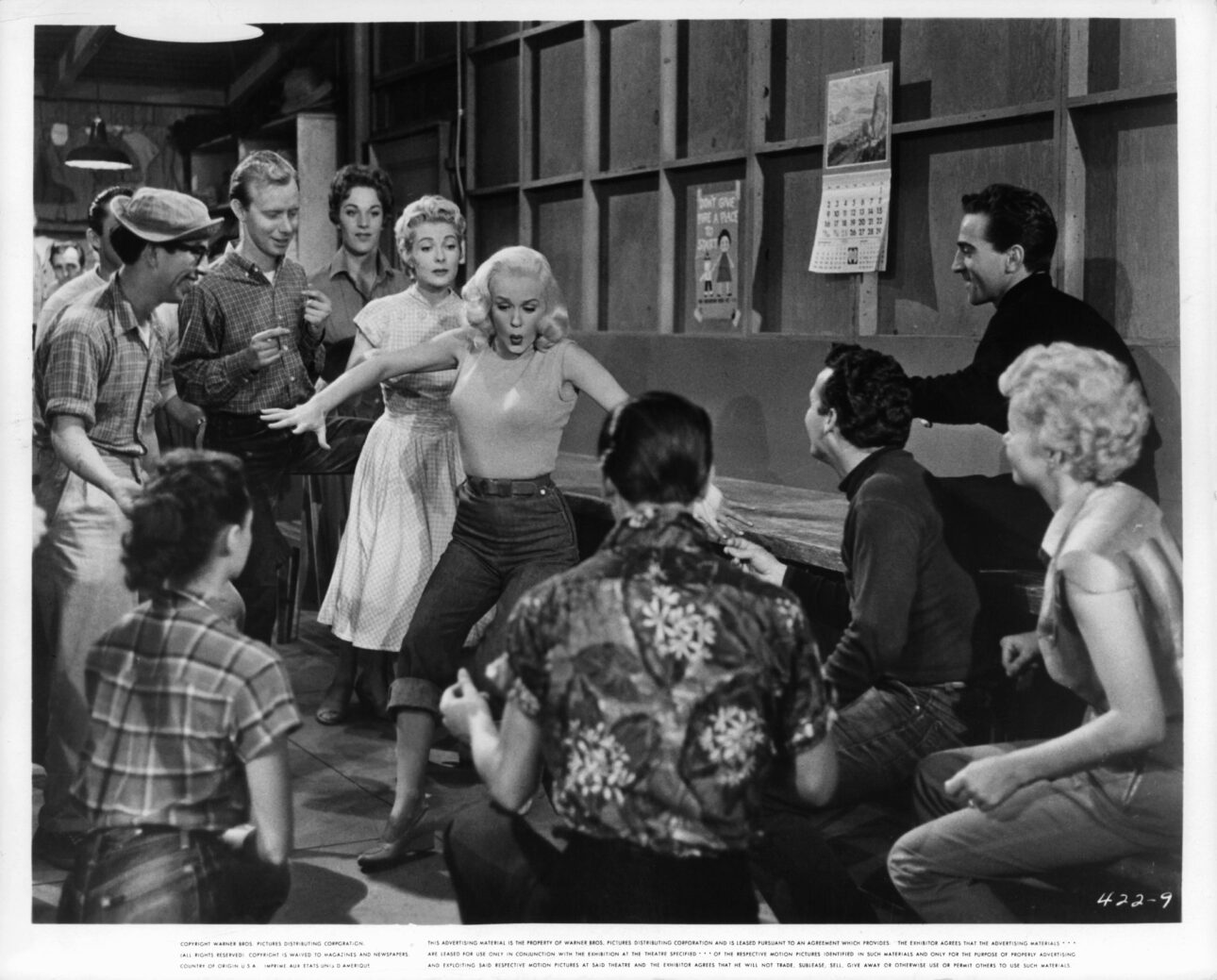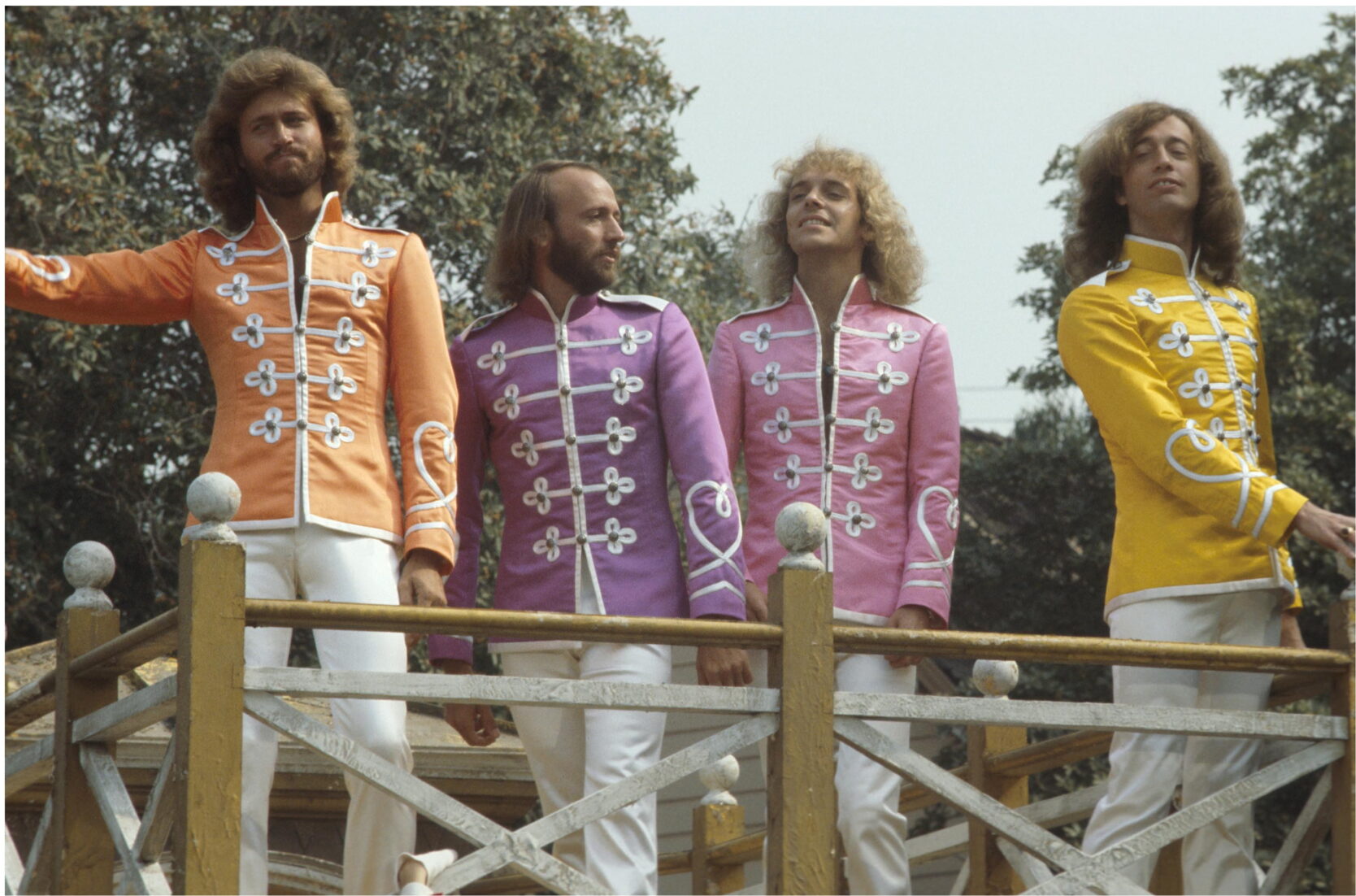In 1957, Warner Brothers released a low-budget teensploitation flick called Untamed Youth, which has the distinction of being the first movie to feature a woman singing rock and roll–at least according to its star. The film’s “untamed youth” break into song frequently and dance wildly around the barracks of the prison farm, with Mamie Van Doren and Eddie Cochran taking lead on songs penned by exotica legend Les Baxter. It’s an infamous turkey of a film, even riffed on the first season of Mystery Science Theater 3000, and if it had a soundtrack, it would surely be considered among the worst of all time. Baxter was obviously slumming in the teen market, as his songs are all wonky and askew—a square’s take on hip tunes.
But it’s not entirely his fault. Singing wasn’t among Van Doren’s primary or even secondary talents. She never really gets hold of “Salamander,” and the less said about her stab at calypso—a very violent stab—the better. What she lacks in pitch and nuance and charisma, however, she makes up for with the sheer brute force of her delivery: Nothing’s gonna stop her from putting these songs over. She was, naturally, the film’s star and the only artist credited to the seven-inch single from the film. It’s as close as Untamed Youth ever got to a soundtrack.

The film predates the soundtrack era, which used the Broadway cast recording template to market teener flicks with tie-in albums. Pop stars started stepping in front of the camera just to chart more hits, but as the Beatles made pop art and auteurs started tinkering with Hollywood formulas, the possibilities for soundtracks expanded exponentially. A good soundtrack can take any form: a standalone score (Duke Ellington’s Anatomy of a Murder) or a collection of new songs (Prince’s Purple Rain) or a collection of old songs in a new context (Pulp Fiction) or some hybrid of pop and score (Rushmore). While the digital era has made the form much less bankable, we still get blockbusters like Guardians of the Galaxy and Barbie.
Similarly, a bad soundtrack can take any form. Some are failed experiments, others souvenirs from vanity projects. It might be an artifact of a short-lived pop trend that sounds baffling beyond its moment, as with the symphony-and-synths Ladyhawke (although, call me crazy, that one’s actually kinda fun). It could be one of those old-school insults to disposable income, such as Benny & Joon or Batman Returns, which demanded $15+ for one pop song and 50 minutes of blah score.
And then there are those soundtracks to cult films, whose badness is their entire appeal. The Apple, a disco musical from 1980 that’s less Xanadu and more Xanadon’t, is beautifully corny, and who would want it any other way. And the score from Manos: Hands of Fate is deeply weird, but like the film itself, that soundtrack casts a strange and utterly singular spell. After a while, bad becomes more a genre than a criticism.
Below are 10 truly bad soundtracks. Some rise to the level of so bad they’re good, but most are just, well, bad.
Easy Come, Easy Go (1967)
Of course we’re starting with Elvis. He may be the first true pioneer of the bad soundtrack. The same year the Doors and the Velvet Underground released their debut albums, Presley gave the world Easy Come, Easy Go, his umpteenth teen flick, in which he played a deep-sea diver and nightclub singer who… well, there’s no real plot to sum up. The film and its soundtrack (originally a six-song EP, later expanded on a reissue with Speedway) represent the twin nadirs of his recording and acting careers. The title track is the best song here, because it’s merely forgettable. “The Love Machine” is awkward and nonsensical, but “Yoga Is As Yoga Does” is grandiose in its stupidity. It’s special. One of far too many novelty hits from this phase of Elvis’s career, it’s a sad stab at counterculture commentary—“How can I even move, twisted like a pretzel?”—with Elvis sounding hoarse, very likely high, and barely committed to any single note. You can hear the moment he just gives up. The song was later included on the infamous ‘80s bootleg Elvis’ Greatest Shit!
(Bonus trivia: Closer “I’ll Take Love” was co-written by Dolores Fuller, best known for appearing in several of Ed Wood’s films.)
Lost Horizon (1973)
More than any other film on this list, Lost Horizon had the potential to be a classic. The film, a remake of the 1937 adaptation of the 1933 novel, was a prestige pic directed by the respectable Charles Jarrott and starring Peter Finch, Michael York, George Kennedy, John Gielgud, and Olivia Hussey. The music was written by Burt Bacharach and Hal David, who were removed from their natural habitat—the 1960s—but were still producing hits. From the opening credits sequence you know something’s off: “There’s a lost horizon waiting to be found,” Shawn Phillips sings on the opening track, as though they had to cram the title in there somewhere. With none of the nuance and very little of the melancholy that defined the duo’s biggest hits, songs like “Living Together, Growing Together” and “The World Is a Circle” reduce a complex story of colonialism down to its most basic tropes. “Different people look at life from different points of view,” two characters actually sing. Why would anyone want to stay in a place with so many bad songs in the air? The film was a boondoggle, losing millions. The soundtrack was moderately successful, with Herb Alpert, Marvin Gaye, and others covering a few of its songs. But the project brought Bacharach and David’s long collaboration to an acrimonious end.
Take Me High (1973)
Years before he became a recurring joke on The Young Ones, Cliff Richard had a not-altogether embarrassing film career full of light flicks that made back their meager budgets without adding anything to the art of cinema. That is, until he starred in a stinkburger of a film about a bank exec exiled to Birmingham (U.K., not AL). Take Me High was so bad that he never starred in another movie again. A big factor in the debacle is the soundtrack, full of awkward melodies, clunky concepts, and odd lyrics courtesy of an Australian troubadour named Tony Cole. “It’s Only Money” must have sounded like an insult during the recession (“it’s only bread, don’t let it go to your head”) and “Join the Band” is a sing-along thwarted by its own chockablock rhythms. Credit Cole with consistency: Every song contains at least one ambitious faceplant, whether it’s rhyming “break your necks” with “planetary apoplex” or having the whitest dude in England sing to himself, “You used to be a man of color, now you’re midnight blue.”
At Long Last Love (1975)
Peter Bogdanovich was coming off a string of big hits (The Last Picture Show, Paper Moon) when he decided to turn a bunch of Cole Porter songs into a movie. He wrote the screenplay himself and gathered a remarkable cast including girlfriend Cybill Shepherd, Burt Reynolds, and the great Madeline Kahn. “The only problem was, nobody in the cast could sing,” Peter Biskind writes in Easy Riders, Raging Bulls before he mercilessly compares the director’s ego (you’re the top) with the box office returns (you’re the bottom). It’s the vainest of vanity projects, and Bogdanovich’s comeuppance was celebrated throughout Hollywood. Nearly 50 years later, the soundtrack is still soaked in flop sweat. Reynolds, wildly miscast, tries valiantly to sound frivolously urbane rather than affably southern, and Shepherd delivers her numbers with none of her usual comic charm. Compare that with her musical numbers on Moonlighting a decade later, and you start to blame the director.
All This and World War II (1976)/Sgt. Pepper’s Lonely Hearts Club Band (1978)
The self-congratulatory Beatles covers album is its own strange subgenre of bad soundtracks. In the 21st century, we’ve already been bombarded with I Am Sam, Across the Universe, and, most annoyingly Yesterday, all of which take as a given that the Beatles are the keystone of all global culture. But those are mere trifles compared with this duo of ‘70s filmic artifacts that possess the singularly lofty ambition to be truly baffling. All This and World War II paired ‘40s newsreels, film clips, and war footage with covers of Fab Four hits by Peter Gabriel (okay, sure), Bryan Ferry (makes sense), Henry Gross (of “Shannon” fame?), the Four Seasons (huh?), and a pre-Grease Frankie Laine. Helen Reddy sings “The Fool on the Hill” over grainy footage of Hitler, and Leo Sayer shouts “I Am the Walrus” during the attack on Pearl Harbor. The film plays like Peter Jackson mixed up the canisters for 2021’s The Beatles: Get Back and 2018’s They Shall Never Grow Old.
But that experimental flop is a masterpiece compared to Sgt. Pepper’s Lonely Hearts Club Band, a film/soundtrack pairing that squandered all the good will producer Robert Stigwood and the Bee Gees had built up with Saturday Night Fever. It’s audacious in its awfulness, as though the crew deliberately made the wrong choice in every single creative decision. For example, Billy Shears is played by Peter Frampton circa the guitarist’s ‘77 I’m in You LP, Donald Pleasence struggles through “I Want You (She’s So Heavy),” and Steve Martin can’t get a laugh with his take on “Maxwell’s Silver Hammer.” Only Earth Wind & Fire emerge with their dignity intact, turning in a supremely funky “Got to Get You Into My Life” that actually rivals the original. It’s so good it makes everything else on this double (!!) album sound even worse. The real tragedy, however, is that neither the film nor the soundtrack is so bad it’s good. They’re just bad. Which is sad.
Black Roses (1988)
Like all Satanic Panic metal flicks, Black Roses wanted to have it both ways: It wanted to expose the demonic forces animating heavy metal, and it wanted a kickass soundtrack that would appeal to metalheads. In the film a band called Black Roses tease their hair high, play tacky instruments poorly, and tour in a fleet of Lamborghinis. It’s all very realistic, until the musicians reveal themselves to be ghouls harnessing the power of true metal to hypnotize the youth of America. Director John Fasano knows how to walk the line between rockin’ and ridiculous (he directed the glorious cult flick Rock ‘n’ Roll Nightmare, starring Jon Mikl Thor), but here he slips into the latter, thanks to a wan soundtrack that wouldn’t convince even the nerdiest teenager to cash in his soul. If Lizzy Borden’s “Me Against the World” is the heaviest metal on your album, maybe Satan really is winning.
Teenage Mutant Ninja Turtles 2: The Secret of the Ooze (1991)
Forget for a moment that Vanilla Ice rang in 2024 onstage at Mar-a-Lago. Forget that he starred in Cool as Ice and told another human being to “drop that zero and get with the hero!” Forget all that and try to take in “Ninja Rap” free of context or prejudice. The lead single in the second installment of the Turtles’ Disturbing Rubber Suit Trilogy, “Ninja Rap” is still a mess of janky New Jack beats and first-draft lyrics, but the Ice man manages to keep a straight face while rapping, “Have you ever seen a Turtle get down?” That constitutes a win for Robbie Van Winkle, which disqualifies him as the saddest part of this Kowabungled soundtrack. Who does that leave? How about Dan Hartman, losing whatever steam he had with “I Can Dream About You” as he attempts to spit verses on “(That’s Your) Consciousness”? What about Spunkadelic—who chose that band name? Nah, it’s Ya Kid K, who, as the singer for Technotronic, delivered the most memorable hit in jock jam history. In the Turtleverse she’s reduced to delivering lines like “Ninja Turtles are awesome!”
Threesome (1994)
In 1994 Lara Flynn Boyle, Josh Charles, and a Baldwin brother appeared in a film that was almost sexually progressive at the time and today is fully retrogressive. But its most heinous crime is this soundtrack. It is the worst album I’ve ever heard. I have a suspicion (unconfirmed) that it started as a covers compilation, which makes a certain kind of strained sense: a bunch of threesomes between the original artists, the songs, and the covering artists. For reasons lost to time, that concept fell apart and we got scraps. Teenage Fanclub’s awkward “Like a Virgin” sounds about as sexy as fumbling with the back of a front-clasp bra, and Duran Duran’s karaoke-night “Come Up and See Me (Make Me Smile)” could have been recorded on a flip-phone in someone’s pocket. Just when you think it can’t get any lower, along comes General Public’s “I’ll Take You There,” a rave-reggae cover that turns the Staple Singers’ civil rights anthem into a horndog headslap. This CD marks the end of the ‘90s dream.
Queen of the Damned (2002)
The seas will boil, and the sun will burn out, and nu-metal will get its own critical reassessment. The day is coming, and we should all be prepping. And maybe a future generation will look back at the fin de siècle moment when every B-level-and-lower horror/action hybrid had mindless editing, no color palette, and rap-rock bands on the soundtrack. Until that dreadful day, Queen of the Damned will continue to sound like a vanity project gone terribly wrong. Originally conceived as a solo project for Korn’s Jonathan Davis, it features several of his own songs mangled by the likes of Jay Gordon (remember Orgy?) and Marilyn Manson, along with a few originals by Disturbed, Kidneythieves, and Papa Roach. Its only saving grace: a duet between Tricky and Alanis Morissette, both of whom deserve better.





